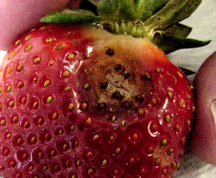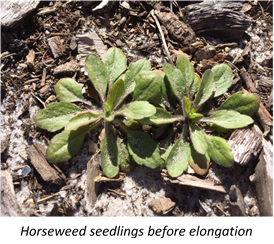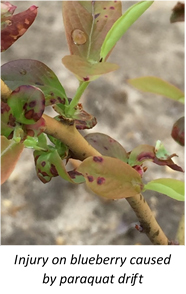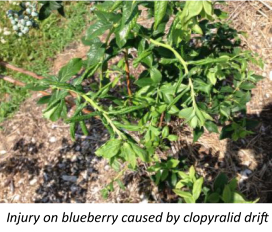Like clockwork, purple spot has appeared in some asparagus plantings during mid- to late-April for the past 3 years. Purple spot, caused the soil-borne fungus, Stemphylium vesicarium, can cause problems during cool, wet spring weather (much like we have had over the past week or so). Symptoms, just like its name, include numerous, sunken oval-shaped spots on spears during the harvest season and more importantly on ferns and stalks during the summer months as long as conditions are ideal for its development. Often, purple spot will disappear as quickly as in appears on spears during the spring production season depending on the local weather conditions. As soon as the weather becomes dry and warm (as it appears for the weekend), expect purple spot to disappear. [Read more…]
Archives for April 2017
2017 New Jersey Commercial Tree Fruit Production Guide
Dear Fruit Growers,
The 2017 New Jersey Commercial Tree Fruit Production Guide is available electronically for free. Anyone may print paper copies if they choose to. If you already have a copy of 2016 NJ Commercial Tree Fruit Production Guide, you only need to print 10 page addendum (first 10 pages), available at: https://njaes.rutgers.edu/pubs/publication.asp?pid=e002.
Print copies of 2017 NJ Tree Fruit Production Guide available for $25 per copy.
For North Jersey, please contact: Diana Boesch: email – boesch@njaes.rutgers.edu or Phone – 908 -788-1339
For South Jersey, please contact: Joan Medany: email – jmedany@co.gloucester.nj.us or Phone – 856-307-6450 ex. 1
Controlling Strawberry Fruit Rots – 2017

Anthracnose Fruit Rot of Strawberry
Fruit rots in strawberry can cause significant losses if not recognized early and controlled. The use of good cultural practices such as keeping fields weed-free and promoting good drainage, long crop rotations, and preventative fungicide applications are critical.
Pathogens such as anthracnose, gray mold (Botrytis), and leather rot (Phytophthora) can become systemic problems in strawberry plantings once established. All three fungal diseases are soil-borne and once in fields can be difficult to manage over the lifetime of the planting.
The use of mulch (matted rows) to prevent/reduce soil splashing and keeping fruit from coming into direct contact with the soil surface can be beneficial in organic production systems where conventional fungicides cannot be used. Use of long crop rotations and staying away from areas of the farm with known instances of any of these pathogens is also important. Remember that same species of Colletotrichum that causes fruit rot in pepper and other crops can also infect strawberry.
UMaine to Hold International Potato Disease Summit Nov. 9, 2017
Orono, Maine — Two bacteria threatening the potato industry worldwide will be the focus of a Potato Disease Summit Nov. 9 in Bangor, Maine, convened by the University of Maine.
Plant pathologists, researchers and scientists from The Netherlands, Scotland and five U.S. states will present the latest information on the bacteria — Dickeya and Pectobacterium — that cause blackleg disease, an emerging potato seed problem.
In the past three growing seasons, Dickeya, a bacterial pathogen of potatoes, has caused significant economic losses in seed nonemergence and crop loss nationwide. In addition, an associated pathogen, Pectobacterium, has caused potato crop losses in the field and in storage. The bacteria have caused losses to the potato industry in Europe for an even longer period.
“The University of Maine is responding to this situation by holding an international summit focused on the latest research and what steps are needed to help the potato industry,” says University of Maine President Susan J. Hunter. “As Maine’s only public research university, we are a longstanding partner with the state’s potato industry in addressing its needs, including the growing threat posed by Dickeya and Pectobacterium.”
The Potato Disease Summit, 8 a.m.–5 p.m., Nov. 9 at the Cross Insurance Center, 515 Main St., Bangor, Maine, is designed for scientists, consultants, regulatory officials, and potato seed growers and buyers. It will focus on such topics as current advances in detection and diagnosis of Dickeya; an overview of Pectobacterium in the U.S.; and management of Enterobacteriaceae spread and risk.
The $80 per person fee includes materials, lunch and breaks. Registration deadline is Oct. 2 and is available online: extension.umaine.edu/agriculture/programs/dickeya-and-pectobacterium-summit.
For more information or to request a disability accommodation, contact Steve Johnson, 207.554.4373, stevenj@maine.edu.
Allium Leafminer Alert III in New Jersey
As of Friday, April 21, we confirmed that ALM is in south Jersey and it is likely that it can be found throughout the state. Infested field chives were found in East Vineland as well as in backyard chives in Atlantic County and onion sets in the Middlesex/Monmouth County area. Feeding scars have been found in wild garlic which is abundant in New Jersey. So far, adult flies have only been trapped in chives. Given how chives are harvested, it is difficult to assess how damaging the fly will be to the chive crop. More of a problem will be protecting longer term crops like leeks and onions. [Read more…]
Controlling Emerged Marestail in Blueberry
In spring, one  of the first weeds that will break through the residual herbicide coverage provided by preemergence applications is horseweed, aka marestail. Horseweed has two primary periods of emergence, from late March through June and from late summer through late fall. Some of the most problematic horseweed emerges in the fall and over winters as small rosettes. If growers don’t control it with fall-applied residual herbicides, the weed has an excellent head start on the spring growing season, especially after a mild winter. Horseweed plants remain in the rosette stage through mid-April, followed by stem elongation (bolting) and rapid growth to an height of 3 to 6 feet. Plants that emerge the previous fall will bolt earlier than spring-emerging plants. Horseweed is most easily controlled when in the seedling, or rosette stage, and spring postemergence herbicides should be applied before stem elongation.
of the first weeds that will break through the residual herbicide coverage provided by preemergence applications is horseweed, aka marestail. Horseweed has two primary periods of emergence, from late March through June and from late summer through late fall. Some of the most problematic horseweed emerges in the fall and over winters as small rosettes. If growers don’t control it with fall-applied residual herbicides, the weed has an excellent head start on the spring growing season, especially after a mild winter. Horseweed plants remain in the rosette stage through mid-April, followed by stem elongation (bolting) and rapid growth to an height of 3 to 6 feet. Plants that emerge the previous fall will bolt earlier than spring-emerging plants. Horseweed is most easily controlled when in the seedling, or rosette stage, and spring postemergence herbicides should be applied before stem elongation.
Treating them early is the key to success. Control of horseweed when its 2 to 4 inches is more likely than when it’s over 10 inches tall. Remember, most of the horseweed in New Jersey is resistant to glyphosate and there is a good probability that our populations are also resistant to ALS herbicides such as halosulfuron (active ingredient in Sandea) or rimsulfuron (active ingredient in Matrix). So, the most consistent options to control emerged horseweed include paraquat, clopyralid or glufosinate applied to small plants.

Paraquat – Use 2.4 to 4.0 pints/A of Gramoxone SL 2.0. Gramoxone is a contact killer that has no translocation or residual activity. So, best results will be achieved when seedlings are less than 1 inch in diameter. Two applications, two weeks apart are more effective than a single application. Regrowth may occur from the root systems of established weeds. Always use a nonionic surfactant (0.25% v/v) to improve the weed leaf surface in contact with the herbicide and enhance weed control. Do not allow spray or drift to contact green bark, leaves, or fruit as crop damage may result as shown on the picture. As Gramoxone targets the plant photosystem apparatus, applications made at sunset will increase weed control efficiency by allowing more herbicide to penetrate before being activated by sunlight in the morning.
DANGER: Do not breathe spray mist. Read safety precautions on the label.
 Clopyralid – Use Stinger at 3 to 4 fl oz/A of. Stinger has a 24(c) Special Local Need label for weed control in blueberry since 2013. Stinger acts as both a postemergence foliar absorbed herbicide and a residual herbicide. The initial twisting and curling observed after application to susceptible species is due to the foliar absorption. Do not apply Stinger from one week prior to bloom until one week after bloom. Stinger can eventually be tank-mixed with Gramoxone to increase the spectrum of weeds controlled and defoliate existing foliage of perennial asters, goldenrod species and mugwort. Donot allow spray or drift to contact green bark, leaves, or fruit as crop damage may result as shown on the picture. Time all applications to maintain a 30-day PHI (PreHarvest Interval). Do NOT apply Stinger in a hand-held sprayer used to “spray until wet”. Stinger is a residual herbicide that must be applied on a rate per acre basis with a precisely calibrated sprayer. Read safety precautions on the label.
Clopyralid – Use Stinger at 3 to 4 fl oz/A of. Stinger has a 24(c) Special Local Need label for weed control in blueberry since 2013. Stinger acts as both a postemergence foliar absorbed herbicide and a residual herbicide. The initial twisting and curling observed after application to susceptible species is due to the foliar absorption. Do not apply Stinger from one week prior to bloom until one week after bloom. Stinger can eventually be tank-mixed with Gramoxone to increase the spectrum of weeds controlled and defoliate existing foliage of perennial asters, goldenrod species and mugwort. Donot allow spray or drift to contact green bark, leaves, or fruit as crop damage may result as shown on the picture. Time all applications to maintain a 30-day PHI (PreHarvest Interval). Do NOT apply Stinger in a hand-held sprayer used to “spray until wet”. Stinger is a residual herbicide that must be applied on a rate per acre basis with a precisely calibrated sprayer. Read safety precautions on the label.
Glufosinate – Use Rely 280 at 48 to 56 fl oz/A. Rely is a foliar active, nonselective herbicide that controls a broad spectrum of emerged annual and perennial weeds. Best results are obtained when it is applied to actively growing weeds. Glufosinate does not provide residual weed control but can be tank mixed with residual herbicides for broad spectrum control. Contact of Rely with parts other than mature callused brown bark will result in extremely severe damages to the blueberry bush. Do not apply within 14 days of harvest. Warm temperature, high humidity, and bright sunlight will improve the performance of Rely. Read safety precautions on the label.
